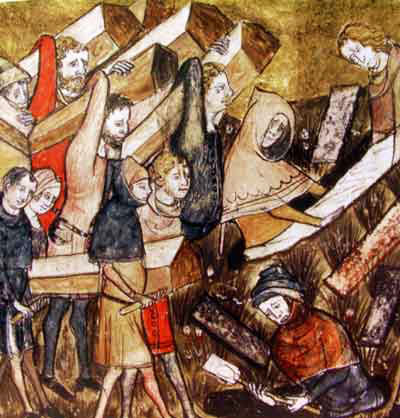Life and Death for Clares in Fourteenth Century Brussels
Much of what is known about the Clarissan convent in Brussels comes from Marie-Jeanne Juvyns's book Le couvent des Riches-Claires à Bruxelles, 1343-1585 (Mechelen: Sint-Francizkusdrukkerij, 1967). The information in this exhibit also relies on an unpublished 2005 paper by Karen Hiles. Hiles is responsible for the discovery that the Plimpton 034 manuscript was copied in the Brussels convent of Saint Clare, based on a common scribe between this manuscript and Bruxelles BR 1870, a capitolarium-collectarium now housed at the Royal Library of Belgium in Brussels.
The Clarissan convent was established in the Notre-Dame de la Chapelle parish in Obbrussel, outside the walls of Brussels close to the Hal gate. The founder, Guillaume de Duvenvoorde, was a nobleman with a professed interest in mendicant orders. In 1344, his petition was approved by Pope Clement VI and thus, the Brussels convent was awarded with all the privileges of an order of St. Clare. The consecration of the abbess, nuns, altars and cemetary took place on August 8, 1348. According to Hiles's estimation, in the mid-fourteenth century, the period of interest in this exhibit, there were around 25 inhabitants of the convent.
Following a 1263 decree from Pope Urban IV, Clarissan nuns were allowed to own property and the order was separated into two parts, the traditional "Poor" Clares and the "Rich" or "Urbanist" Clares. The nuns in the Brussels convent were part of the latter group. Nevertheless, their garb was mostly unchanged and they continued to wear the modest habit Saint Clare herself had been known for. The image to the left displays two Clarissan nuns in traditional habit expressing devotion to Saint Clare. It comes from the Fieschi Psalter (Walters Manuscript W.45), a late thirteenth-century northern French document, which shows many images of Saint Clare and Saint Francis. The Fieschi Psalter is housed at the Walters Art Museum in Baltimore.
The Clares of Brussels sought multiple indulgences for burial since the establishment of the convent. The founder of the monastery, Guillaume de Duvenvoorde, obtained a number of these indulgences for himself and for others. In 1364, the abbess Béatrice de Muysen requested from Pope Urban V the right for all Clarissan sisters at the convent to be buried there. In addition, permission was obtained for the convent to be burial ground for laypeople at a price of 5 florins.
The benefits of being buried in a convent were multiple. Burial in a church displayed loyalty and belonging to a community. For the Clares in Brussels this was most likely the primary reason for wanting to be buried in their convent. Further, as art historian Paul Binsky describes in his book Medieval Death: Ritual and Representation (Ithaca: Cornell University Press, 1996), the graveyard was often a site of social taboos beginning in the High Middle Ages. Therefore, to prevent their graves from dessecration, many people who could afford to do so preferred to be buried in an enclosed space.
Although the manuscript makes no reference to the Black Death, it is important to remember that it is during the mid fourteenth century that it arrived in Brussels. In the image to the right, the artist has portrayed the overwhelming amount of bodies who needed swift burial in the region at the time. The image is from the "The Chronicles of Gilles Li Muisis", also housed at the Royal Library of Belgium in Brussels and is relatively contemporary to Plimpton MS 034 as well as to the establishment of the Clarissan convent.


